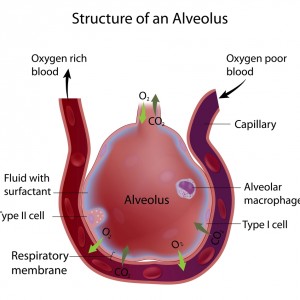 A new study on Acute Exacerbation of Idiopathic Pulmonary Fibrosis entitled “Macrophage Activation in Acute Exacerbation of Idiopathic Pulmonary Fibrosis” was published in PLOS One by Jonas Christian Schupp, part of Dr. Antje Prasse’s group at Department of Pneumology at the University Medical Centre in Freiburg, Germany. In this study, the research team characterized the type of activation of the alveolar macrophages from IPF patients with acute exacerbation.
A new study on Acute Exacerbation of Idiopathic Pulmonary Fibrosis entitled “Macrophage Activation in Acute Exacerbation of Idiopathic Pulmonary Fibrosis” was published in PLOS One by Jonas Christian Schupp, part of Dr. Antje Prasse’s group at Department of Pneumology at the University Medical Centre in Freiburg, Germany. In this study, the research team characterized the type of activation of the alveolar macrophages from IPF patients with acute exacerbation.
Idiopathic Pulmonary Fibrosis (IPF) is a disease of the lung characterized by a progressive scarring, fibrosis, of the lung tissue that leads to a decrease of functional lung volume and oxygen uptake. The origin of IPF is not known; many people live only for 3 to 5 years after diagnosis and the disease has no cure. The main cause of death of IPF is respiratory failure. Acute exacerbations are episodes where an accelerated progression of respiratory symptoms and deterioration of pulmonary function occurs. The acute exacerbation of IPF (AE-IPF) has an extremely poor prognosis and is believed to occur per year in 5-10% of patients with IPF. IPF as well as other fibrotic lung diseases have been associated with alternative activation of macrophage (M2), which is induced by anti-inflammatory (Th2) cytokines that play a crucial role in cancer progression and wound healing. In humans with IPF and animal models of this disease it was shown a profibrotic role of alveolar alternative activated macrophages (M2).
The research team analyzed the bronchoalveolar lavage (BAL) and BAL differential cell counts of 71 patients with or without acute exacerbation and compared with 20 healthy individuals. Patients with other diseases like collagen vascular disease, occupational diseases of usual interstitial pneumonitis were excluded from the study. Among all the IPF patients, 12 were diagnosed with AE while 16 patients developed AE after 24 months. In BAL-cells, they assessed the levels of IL-1ra, CCL2, CCL17, CCL18, CCL22, TNF-α, IL-1β, CXCL1 and IL-8 by ELISA.
[adrotate group=”7″]
The researchers found that among AE patients the percentage of neutrophils existent in BAL was considerably higher than in patients without AE. In BAL cells, the levels of pro-inflammatory (Th1) cytokines CXCL1 and IL-8 together with M2 cytokines were increased. During AE, there was an increase in the levels of CCL18 and higher numbers of neutrophils in BAL cells. Importantly, higher control levels of CCL18 were a prognostic factor for the development of acute exacerbations.
The findings of these study show that during acute exacerbation, cells from BAL express more pro-inflammatory as well as anti-inflammatory (M2) cytokines. Notably, these results suggest that the occurrence of AE in IPF is a consequence of various cellular mechanisms as well as activation of type M2 macrophages.


(PULMONARY FIBROSIS SUCCESSFUL TREATMENT)
I’m from MaryLand USA, I was diagnosed with Pulmonary fibrosis in Feb 2011. I may have had it for 1 or 2 years prior to that. It started with a dry cough and mild temperature, shortness of breath and fatigue. A CT scan confirmed it and I was placed on prednisone (7.5 mg), azathioprine and N-Acetyl. As the disease progressed all medication stopped working, i was introduced to NewLife herbal clinic in South Africa who have successful herbal treatment to Pulmonary fibrosis and other lungs diseases. I spoke to few people who used the treatment here in USA and they all gave a positive response, so i immediately purchased the Pulmonary fibrosis herbal remedy and commenced usage, i used the herbal supplement for only 9 weeks, all symptoms gradually faded away, herbs are truly gift from God. contact this herbal clinic via their email (newlifeherbalclinic @ gmail. com or visit www. newlifeherbalclinic. weebly. com)